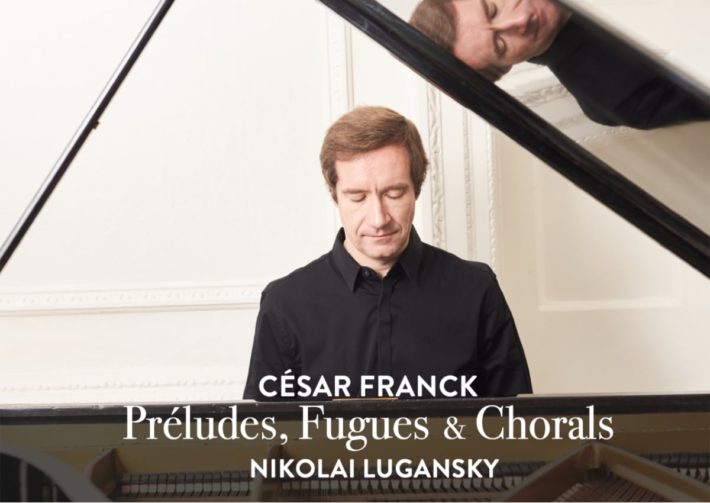It’s not often that we see a complete program of César Franck’s piano music, certainly less so than other composers who comfortably fill complete albums. A superb album by Bertrand Chamayou comes to mind as a superb example, and here we have another take on the same program with no less significance.
The Prelude, Chorale, and Fugue has Franck’s characteristic religious undertones and cyclical form, carrying a spiritual depth in its anguish and eventual catharsis. Lugansky vividly captures the pathos of the Prelude. His dramatic interpretation takes liberties in expanding ritardandos and maximizing the low bass; it also effectively juxtaposes flowing, melodic sections with arresting interludes. There is, however slight balance issues – accompanimental figures sound too subdued where there is room to create more subtle distinctions; this might have helped to contour phrases by creating the perception of a “third line” (0’07-0’11), and would bring out the prelude’s interesting complexity.
The Chorale I found a little disappointing because the interesting harmonic movement is not given enough focus. For example, the arrival at the B-flat chord ++time++ is an emotionally powerful and enlightening moment, which the pianist’s tone quality doesn’t reflect. A bigger issue, however, is voicing: the topmost melodic notes of the rolled chords are completely missing the first instance. While it seems like Lugansky intended to create a large-scale crescendo (the same notes in later repetitions are clear), this is a perplexing stylistic choice and one that is not consistent with the lovely way Lugansky voices the rest of the Chorale.
The Fugue also has its hits and misses. While the themes are prominent, the non-thematic lines are overly legato and blurred – I would also have loved to hear more attention given to their interesting chromatic movement. The cyclical culmination of the work is a momentous combination of the Prelude’s texture and the intertwined themes of the Fugue and Chorale. Lugansky puts emphasis on the fugal theme, but so much that the chorale theme is drowned out. Despite these points, there are some lovely moments of musicality: the return of the Prelude is a beautiful and well thought-out respite between the intense sections that surround it.
Related Classical Music Reviews
- Review: Franck – Piano Solo Pieces, Piano Quintet – Michel Dalberto
- Review: Franck and Chopin – Cello Sonatas – Gautier Capuçon, Yuja Wang
- Review: Saint-Saëns – Piano Concertos 3 and 5 – Lortie, Gardner
The Prelude, Aria, and Finale is, in a way, a complement to the previous piece: the religious chorale is replaced by a secular aria, and the melancholy drama by optimism. Lugansky’s performance here is much stronger. I found his sound-control to be rather impressive: despite the upper register of the piano sounding, naturally, a little stringy, he tempers it masterfully, resulting in a crystalline clarity. His Prelude is expansive yet pensive, quite different when compared to Alfred Cortot’s famous 1932 recording, which is brisker and has march-like energy. The Aria is delicate, though seasoned listeners might find phrases which, at times, tend to be too static. The pianist presents an interesting relationship between major and minor tonal areas, as well as nuanced moments of conflict when the two intertwine. Comparing this performance to Jorge Bolet’s late 1988 Decca recording, It’s interesting to see how the two artists take different approaches to the opening: where Lugansky is expansive and orchestral, Bolet places more emphasis on the melody, creating the declamatory quality of a recitative.
The Finale is a fine performance of powerful virtuosity and dynamic musicality. Different motivic materials have their unique and vibrant characters. For example, the staccatos growl ominously while the two-note phrases are pleading in nature. The moments when these motives come together are particularly exciting (2’33”-2’48”): the staccatos almost encroach upon the lyrical melody, letting us know that the piece is about to take another developmental turn. The pianist’s ending is well-executed: it is both reflective of the Aria’s meditativeness and acts as a luminous calm after the storm.
The Prelude, Fugue, and Variation is excellent. Originally composed for the organ, and later arranged for a “orgue harmonium et piano” by the composer, it is clear that Lugansky approaches this work from the mindset of an organist. Playing Harold Bauer’s piano transcription of the piece, the evenness of Lugansky’s chordal voicing, the resonance of the bass, and his excellent legato capture the best qualities of both instruments. The Variation is a highlight: it is introspective and considers the compositional and emotional trajectory of the entire work. In many ways, it speaks to similar sensitivities heard in the “Aria of the Prelude, Aria, and Finale”. The Trois Chorals pour grand orgue is a lovely closure to the album. Lugansky’s transcription harnesses the power of the modern piano and his virtuosity to reflect the awesome grandeur of the original version for organ.
The piano used here (a Steinway D “Henry” model according to the booklet) has an intriguing quality: each register seems to have a distinct character, from the sharp and almost shrill edge of the higher notes to the warm, enveloping bass. Apart from some inconsistencies in the Prelude, Chorale, and Fugue, this album is solid and a worthy listen for those seeking a dramatic interpretation of Franck’s works.

César Franck – Piano Works
Prélude, choral et fugue CFF 24
Prélude, aria et final CCF 26
Prélude, fugue et variation CFF 30B (arr. Bauer)
Choral pour grand orgue no 2 CFF 106 (arr. Lugansky)
Nikolai Lugansky – Piano
Harmonia Mundi, CD HMM 902642
Franck Piano Works – Recommended Comparisons
Read more classical music reviews or visit The Classic Review Amazon store
Follow Us and Comment:
Get our periodic classical music newsletter with our recent reviews, news and beginners guides.
We respect your privacy.








